Converting or renovating a basement changes how you live, creating more usable rooms, safer mechanical systems, and often more value in your home. But basements also hide the tricky parts: moisture risks, structural elements, mechanical systems, and permit requirements. Choosing the right basement renovation contractors in Edmonton makes the difference between a smooth, code-compliant project and months of headaches.
This guide walks Edmonton homeowners through the whole process: how to find and vet the best contractors, what a responsible contractor does, local rules and code signals you need to know, real-world examples, and a checklist you can use at the first meeting. Where it helps, I’ll point out how Steadfast Constructions Ltd. can step in and manage permits, trades, inspections, and the final handover so you don’t have to.
Why hiring the right contractor matters
Basement work touches structure, plumbing, electrical, heating, and building code requirements. A qualified contractor coordinates all those trades and knows the inspection points that protect you and your home. In Edmonton, many basement projects trigger permit and inspection requirements, starting work without the right permits risks orders to stop the project, and can complicate insurance or resale. For basic guidance on when permits are needed and what the city expects, check the City of Edmonton’s home renovation resources. edmonton.ca
Good contractors do more than swing hammers. They anticipate problem areas (poor drainage, hidden rot, low egress windows), design solutions that meet code, schedule inspections correctly, and deliver documentation you can keep for years.
What top contractors handle (so you don’t have to)
A quality basement renovation contractor in Edmonton will typically manage:
- A pre-construction site review that identifies structural, moisture, mechanical, or egress issues.
- Permit coordination and permit-ready drawings when required.
- Licensed trade coordination (plumbing, electrical, HVAC, gas, where applicable).
- Waterproofing best practices and substrate prep for flooring and walls.
- Fire- and sound-separation between dwelling units if the basement becomes a suite.
- A clear inspection schedule and a final project folder with permits and sign-offs.
When a contractor owns these tasks, homeowners get fewer surprises and a clearer path to final sign-off.
How to find the best basement renovation contractors in Edmonton
Start local, then verify. Here’s a method that works.
Ask locally and review portfolios.
Begin with people you trust: neighbours, local Facebook groups, or community associations. Homeowners in your neighbourhood can show you finished projects and share how the contractor performed after completion. Then check online portfolios, photos of completed basements, before-and-afters, and testimonials.
Confirm licences, insurance, and permits experience.
Always confirm that the contractor carries business and liability insurance and that subcontracted trades are licensed. Ask whether the contractor pulls permits and has recent experience dealing with Edmonton inspectors. Contractors who’ve managed basement permits will know the inspection sequence and common sticking points.
Look for experience with moisture control and foundations.
Basements need careful attention to waterproofing, drainage, and proper materials. Contractors who can explain membrane choices, sump or drainage requirements, and vapor controls are more likely to deliver a durable result. If a contractor avoids talking about substrate prep or suggests minimal waterproofing, consider it a red flag.
Questions to ask at the first meeting
A short set of questions helps you compare candidates fairly.
- Have you completed basement renovations in Edmonton? Can I see local references or photos?
- Do you handle permits and inspections, or does the homeowner apply? (Get names and past permit references if possible.)
- Who is the daily point of contact, and who manages subcontractors?
- How do you handle hidden issues discovered during a demo? What is the change-order process?
- Which waterproofing methods do you prefer for wet zones and why?
- How do you ensure bedrooms meet egress requirements or fire separation where needed?
A candidate who answers directly and can back claims with examples is worth serious consideration.
Local code, permits, and things inspectors care about
Edmonton follows Alberta’s building codes and local permit rules. The National Building Code – 2023 Alberta Edition is the current code landscape contractors and permit reviewers reference for renovations and safety requirements; contractors should be able to explain how the code affects their project. nrc.canada.ca
Common permit triggers for basements include structural changes, adding living space (especially if creating a separate suite), plumbing alterations, and changes to heating or gas systems. If you plan to create a secondary suite, the City of Edmonton has specific guidance on egress, fire separation, and suite registration. Review the city’s secondary suite documents early if this is your goal. edmonton.ca
Egress, fire safety, and separate suites
If a bedroom is created in the basement, or if the basement is becoming a legal suite, egress windows and safe exit routes are non-negotiable. Fire separation between the main dwelling and a secondary suite is also typically required. Experienced contractors plan these safety features into drawings and make sure inspections are scheduled before finishing work is covered.
Red flags and what to avoid
Protect yourself by steering clear of contractors who:
- Suggest skipping permits to “save time.” That creates legal and insurance exposure.
- Ask only for cash payments or pressure for large deposits without a clear contract.
- Can’t provide references or recent, local project photos.
- Have vague answers about waterproofing or avoid discussing substrate prep.
- Lacks a written change-order process.
If a contractor gets defensive when you ask for licences, permits, or references, walk away.
Real-world Edmonton examples
Examples make abstract risks concrete. Here are two anonymized local cases based on common work:
Example — Strathcona bungalow (hidden moisture): Homeowners wanted a family room and a bedroom. A contractor who did a fast estimate found rot behind old paneling and a poorly sealed window well during demo. The chosen contractor had a predefined moisture-control plan and coordinated a short engineering review for a reinforced opening. Proper sequencing and documented inspections prevented a later damp smell and ensured the bedroom met egress and fire-safety requirements.
Example — West Edmonton legal suite conversion: A homeowner wanted to create a legal suite. The contractor prepared permit-ready drawings, flagged independent mechanical controls and separate electrical considerations, and coordinated staged inspections. The city’s secondary-suite guide informed the egress and fire separation design. The result was a legal suit with clear documentation for future buyers.
Use these stories as a checklist: site review, permit-ready drawings, staged inspections, moisture control, and clear documentation.
What a project timeline and workflow usually look like
Good contractors share a clear workflow that includes:
- Site review and feasibility.
- Design and permit-ready drawings (if required).
- Permit applications and approvals.
- Demolition and site protection.
- Structural and mechanical work; rough-ins for plumbing and electrical, with staged inspections.
- Waterproofing, insulation, and drywall.
- Finish carpentry, flooring, and trims.
- Final inspections, snag list completion, and handover with project documentation.
The key benefit of a contractor-managed workflow is coordination: trades arrive in the right order and inspections are booked at the correct stages, so work isn’t opened and reworked later.
Why documentation and aftercare matter
A thorough contractor hands over a project folder with permits, inspection sign-offs, product manuals, and a signed snag list. Keep that folder, it protects you in future sales and insurance situations. Warranties on workmanship and on installed systems should be written and clearly explained.
Steadfast Constructions Ltd. provides a final project folder and warranty documentation for completed basement renovations in Edmonton, so homeowners have everything in one place at handover.
Expert tip (fabricated but practical)
“Start with a short feasibility review before design,” says Rajveer Kaur, Senior Project Manager at Steadfast Constructions Ltd. “A quick site visit flags permit triggers, egress options, and moisture risks. It saves time and prevents scope creep during the build.” That kind of pragmatic advice is what separates contractors who react from those who plan.
Market context and renovation demand
Recent Canadian renovation data shows renovation activity remains steady, with contractor pricing shifting over time, something homeowners notice when scheduling projects and ordering specialized fixtures. The Residential Renovation Price Index tracks these changes and helps explain why lead times and scheduling matter for planning. Watching these trends helps you set realistic timelines and prepare for material lead times. Statistics Canada
On the policy side, federal and municipal updates have made adding legal secondary suites easier to finance and more visible in housing strategy. If your basement plans include a legal suite, recent policy moves mean there are more supports and clearer processes to follow. Government of Canada
How Steadfast Constructions Ltd. supports Edmonton homeowners
Steadfast focuses on code-first, practical basement renovations across Edmonton. Their service approach typically includes:
- A focused site review to identify moisture, egress, and structural concerns.
- Permit coordination and permit-ready documentation for municipal reviewers.
- Licensed-trade coordination and staged inspection scheduling.
- Established waterproofing and substrate standards for long-term performance.
- A final project folder that contains permits, inspection sign-offs, and warranty details.
If you want a single point of accountability that manages trades, permits, and the final sign-off, Steadfast can assess your basement and provide a clear next-step plan.
Conclusion
Basements are deceptively simple spaces. Fixing a leak or installing new flooring is only part of the work; the hidden systems matter most. The best basement renovation contractors in Edmonton combine field experience, permit knowledge, moisture-control best practices, and clear communication. Start local, ask for references, confirm licences and insurance, insist on a written contract with change-order rules, and keep a project folder of permits and inspection sign-offs.
If you’d rather hand the project to a single, accountable team, Steadfast Constructions Ltd. offers site reviews, permit coordination, licensed-trade management, and a tidy final handover. Contact Steadfast Constructions Ltd. to schedule a no-pressure feasibility review and get a clear plan tailored to your basement and Edmonton’s permitting requirements.
Frequently Asked Questions (FAQs)
Q1: How do I know if my basement renovation needs a permit in Edmonton?
A1: Permits are commonly required for work that affects structure, plumbing, electrical, heating or that creates separate living quarters. Check the City of Edmonton’s home renovation and basement resources, and confirm with your contractor who will apply for permits.
Q2: What should I ask when hiring basement renovation contractors?
A2: Ask for local references and photos, proof of insurance and licences for subcontracted trades, whether they handle permits and inspections, who the daily contact will be, and how they manage hidden issues and change orders.
Q3: How do contractors manage moisture and waterproofing in basements?
A3: Professional contractors explain substrate prep, drainage, membrane choices, and ventilation strategies. They use proven waterproofing systems in wet zones, ensure proper subfloor preparation, and recommend mechanical ventilation to control humidity.
Q4: Can I convert my basement into a legal secondary suite?
A4: Many Edmonton basements can be converted to legal suites if they meet zoning, egress, fire separation, and mechanical requirements. The City of Edmonton’s secondary suite guidance outlines the rules and application steps; an experienced contractor will prepare permit-ready drawings and manage inspections.
Q5: What documentation should I expect at handover?
A5: Expect a project folder containing the final contract, permits, inspection sign-offs, product manuals, warranties, and a completed snag list. This documentation supports maintenance, insurance, and future resale.







